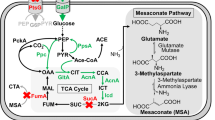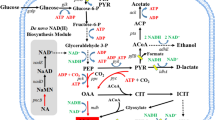Abstract
To produce maltobionic acid (MBA) from maltose in Escherichia coli, we recombinantly expressed a glucose dehydrogenase gene (gdh1) from Enterobacter cloacae and a pyrroloquinoline quinone (PQQ) synthesis gene cluster (pqqFABCDEMIH) from Pseudomonas taetrolens. Although the recombinant E. coli strain (E. coli [pKK-ECGDH1 + pACYC-PQQ]) successfully produced MBA from maltose, the yield of MBA was rather low, indicating that E. coli has other maltose utilization pathways. Amylomaltase (MalQ) is the first enzyme in the maltose utilization pathway in E. coli. To investigate the potential role of MalQ on MBA production, E. coli malQ was inactivated. The culturing of the recombinant E. coli strain (E. coli ∆malQ [pKK-ECGDH1 + pACYC-PQQ]) in a flask resulted in higher MBA production titer, yield, and productivity (209.3 g/L, 100%, and 1.1 g/L/h, respectively) than those of E. coli [pKK-ECGDH1 + pACYC-PQQ] (162.1 g/L, 77.4%, and 0.5 g/L/h, respectively), indicating that the MalQ inactivation was highly effective in improving the MBA production ability of E. coli. After fermentation using 5-L bioreactor, MBA production titer, yield, and productivity of the recombinant E. coli strain were 209.3 g/L, 100%, and 1.5 g/L/h, respectively, which were 1.3-, 1.3-, 2.3-fold higher than those of E. coli [pKK-ECGDH1 + pACYC-PQQ] (167.3 g/L, 79.9%, and 0.65 g/L/h), respectively. Thus, our results provide an important foundation for efficient MBA production using recombinant E. coli strain.





Similar content being viewed by others
Data availability
The data that support the findings of this study are available from the corresponding author upon reasonable request.
Abbreviations
- GDH1:
-
Glucose dehydrogenase
- HMCS:
-
High-maltose corn syrup
- HPLC:
-
High-performance liquid chromatography
- LBA:
-
Lactobionic acid
- MalQ:
-
Amylomaltase
- MBA:
-
Maltobionic acid
- PQQ:
-
Pyrroloquinoline quinone
- WCB:
-
Whole-cell biocatalyst
References
Suehiro D et al (2019) Maltobionic acid enhances intestinal absorption of calcium and magnesium in rats. Biosci Biotechnol Biochem 83(9):1766–1773
Alonso S, Rendueles M, Díaz M (2013) Bio-production of lactobionic acid: current status, applications and future prospects. Biotechnol Adv 31(8):1275–1291
Gutiérrez L-F, Hamoudi S, Belkacemi K (2012) Lactobionic acid: a high value-added lactose derivative for food and pharmaceutical applications. Int Dairy J 26(2):103–111
Suehiro D et al (2020) Maltobionic acid accelerates recovery from iron deficiency-induced anemia in rats. Biosci Biotechnol Biochem 84(2):393–401
Green BA, Yu RJ, Van Scott EJ (2009) Clinical and cosmeceutical uses of hydroxyacids. Clin Dermatol 27(5):495–501
Sarenkova I, Ciprovica I (2018) The current status and future perspectives of lactobionic acid production : a review. Res Rural Dev 1:233–239
Cardoso T et al (2019) Lactobionic acid as a potential food ingredient: recent studies and applications. J Food Sci 84(7):1672–1681
Fukami K et al (2016) Effect of Water Content on the glass transition temperature of calcium maltobionate and its application to the characterization of non-arrhenius viscosity behavior. Food Biophys 11(4):410–416
Mirescu A, Prüße U (2007) A new environmental friendly method for the preparation of sugar acids via catalytic oxidation on gold catalysts. Appl Catal B 70(1):644–652
Oh Y-R et al (2020) High-level production of maltobionic acid from high-maltose corn syrup by genetically engineered Pseudomonas taetrolens. Biotechnol Rep 28:e00558
Oh Y-R et al (2022) Whole-cell biocatalysis using genetically modified Pseudomonas taetrolens for efficient production of maltobionic acid from pure maltose and high-maltose corn syrup. Bioprocess Biosyst Eng 45(5):901–909
Rosano GL, Ceccarelli EA (2014) Recombinant protein expression in Escherichia coli: advances and challenges. Front Microbiol 5:172–172
Sharma A, Chaudhuri TK (2017) Revisiting Escherichia coli as microbial factory for enhanced production of human serum albumin. Microb Cell Fact 16(1):173
Oh Y-R et al (2020) Enhancement of lactobionic acid productivity by homologous expression of quinoprotein glucose dehydrogenase in Pseudomonas taetrolens. J Agric Food Chem 68(44):12336–12344
Han HJ et al (2022) Efficient production of lactobionic acid using Escherichia coli capable of synthesizing pyrroloquinoline quinone. J Agric Food Chem 70(6):1962–1970
Han HJ, Oh Y-R, Eom GT (2022) Isolation and characterization of a new superior lactobionic acid-producing bacterium, Enterobacter cloacae KRICT-1, from environmental soil samples. ACS Food Sci Technol 2(1):66–74
Datsenko KA, Wanner BL (2000) One-step inactivation of chromosomal genes in Escherichia coli K-12 using PCR products. Proc Natl Acad Sci 97(12):6640–6645
Boos W, Shuman H (1998) Maltose/maltodextrin system of Escherichia coli: transport, metabolism, and regulation. Microbiol Mol Biol Rev 62(1):204–229
Park JT et al (2011) Role of maltose enzymes in glycogen synthesis by Escherichia coli. J Bacteriol 193(10):2517–2526
Weiss SC, Skerra A, Schiefner A (2015) Structural basis for the interconversion of maltodextrins by MalQ, the amylomaltase of Escherichia coli. J Biol Chem 290(35):21352–21364
Oh Y-R, Jang Y-A, Eom GT (2022) Valorization of waste cooked rice into value-added maltobionic acid using genetically engineered Pseudomonas taetrolens. ACS Sustain Chem Eng 10(2):810–815
Funding
This work was supported partly by the R&D programs of MOTIE/KEIT (20018375), KRICT (SS2242-10, BSF22-515), and Ulsan-KRICT (US22-03).
Author information
Authors and Affiliations
Contributions
CC: Investigation, validation, data curation, writing–original draft. GTE: Conceptualization, project administration, supervision, writing–original draft, writing–review and editing, funding acquisition, resources.
Corresponding author
Ethics declarations
Conflict of interest
The authors declare no financial or commercial conflict of interest.
Additional information
Publisher's Note
Springer Nature remains neutral with regard to jurisdictional claims in published maps and institutional affiliations.
Supplementary Information
Below is the link to the electronic supplementary material.
Rights and permissions
Springer Nature or its licensor (e.g. a society or other partner) holds exclusive rights to this article under a publishing agreement with the author(s) or other rightsholder(s); author self-archiving of the accepted manuscript version of this article is solely governed by the terms of such publishing agreement and applicable law.
About this article
Cite this article
Cho, C., Eom, G.T. Enhanced production of maltobionic acid by a metabolically engineered Escherichia coli incapable of maltose utilization. Bioprocess Biosyst Eng 46, 507–513 (2023). https://doi.org/10.1007/s00449-022-02835-4
Received:
Accepted:
Published:
Issue Date:
DOI: https://doi.org/10.1007/s00449-022-02835-4




